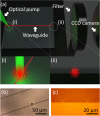Waveguide-Integrated Colloidal Nanocrystal Supraparticle Lasers
- PMID: 38037651
- PMCID: PMC10683367
- DOI: 10.1021/acsaom.3c00312
Waveguide-Integrated Colloidal Nanocrystal Supraparticle Lasers
Abstract
Supraparticle (SP) microlasers fabricated by the self-assembly of colloidal nanocrystals have great potential as coherent optical sources for integrated photonics. However, their deterministic placement for integration with other photonic elements remains an unsolved challenge. In this work, we demonstrate the manipulation and printing of individual SP microlasers, laying the foundation for their use in more complex photonic integrated circuits. We fabricate CdSxSe1-x/ZnS colloidal quantum dot (CQD) SPs with diameters from 4 to 20 μm and Q-factors of approximately 300 via an oil-in-water self-assembly process. Under a subnanosecond-pulse optical excitation at 532 nm, the laser threshold is reached at an average number of excitons per CQD of 2.6, with modes oscillating between 625 and 655 nm. Microtransfer printing is used to pick up individual CQD SPs from an initial substrate and move them to a different one without affecting their capability for lasing. As a proof of concept, a CQD SP is printed on the side of an SU-8 waveguide, and its modes are successfully coupled to the waveguide.
© 2023 The Authors. Published by American Chemical Society.
Conflict of interest statement
The authors declare no competing financial interest.
Figures






References
-
- Bera D.; Qian L.; Tseng T. K.; Holloway P. H. Quantum Dots and Their Multimodal Applications: A Review. Materials 2010, 3 (4), 2260–2345. 10.3390/ma3042260. - DOI
-
- Ghimire S.; Biju V. Relations of Exciton Dynamics in Quantum Dots to Photoluminescence, Lasing, and Energy Harvesting. J. Photochem. Photobiol., C 2018, 34, 137–151. 10.1016/j.jphotochemrev.2018.01.004. - DOI
-
- Klimov V. I. In Nanocrystal quantum dots: from fundamental photophysics to light-emitting diodes and multicolor lasers , International Conference on Ultimate Lithography and Nanodevice Engineering, 2004.
-
- Wang Y.; Sun H. Advances and Prospects of Lasers Developed from Colloidal Semiconductor Nanostructures. Prog. Quantum Electron. 2018, 60, 1–29. 10.1016/j.pquantelec.2018.05.002. - DOI
LinkOut - more resources
Full Text Sources
Research Materials
